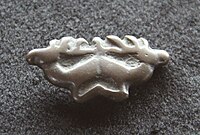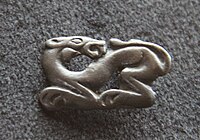Chandman culture
Saka realm ( ), and contemporary cultures and polities circa 325 BCE, with location of the Chandman Ulaangom cemetery ( ) | |
| Geographical range | Western Mongolia |
|---|---|
| Dates | 7th to 3rd centuries BC |
| Preceded by | Deer stones culture |
| Followed by | Xiongnu |
The Chandman culture, also known as Chandmani culture, was a nomadic culture that existed in northwestern Mongolia and southern Siberia during the Iron Age, and is also known as the "Sagly-Bazhy culture" on the Russian side of the frontier. It is associated with the Eastern Scythian/Saka horizon, and is part of the more general Saka Uyuk culture.[1]
History
The Chandman culture was excavated by Russian and Mongolian archaeologists in the 1970s near Chandmani Mountain, which is located near the city of Ulaangom, Uvs Province.
Radiocarbon dating of the Chandman remains ranges from 700 BCE to 300 BCE, a period spanning the Mongolian Iron Age. The Chandman culture has been linked to the nearby cultures at Sagly and Uyuk, and is part of the Scythian Saka culture.
Population
The Chandman population seems to have been in particularly good health, as their skeletal remains show little evidence for pathological disease. Dental and skeletal evidence show no signs of stress.[2] However other analyses have shown injuries in the Chandman population related to horseback riding and combat. Several Chandman graves contained war hammers, and the cranial injuries associated with their use.[3][4] The Chandman population likely practiced dairying, as dental remains show evidence of milk consumption.[5]
Archaeogenetics
A 2020 study analyzed the DNA of Chandman fossils, and described them as a mixed population, with 50% of their ancestry being derived from the West Eurasian
Strong evidence of sex bias was found in the ancestry of the Chandman population.
Chandman males were found to be equally divided between the West Eurasian haplogroup
Jeong, et al. found that the early Western
Gallery
-
Bone arrowheads of Chandmani-Sagil culture, Western Mongolia
-
Bronze daggers of Chandmani-Sagil, Western Mongolia.[11]
-
Bronze mirrors Chandmani-Sagil culture, Western Mongolia
-
Notice about the site of Chandman, National Museum of Mongolia
-
Bronze goat ornament, 700-300 BCE, Uvs Province, National Museum of Mongolia
-
Bronze ornament, 700-300 BCE, Uvs Province, National Museum of Mongolia
-
Bronze ornament, 700-300 BCE, Uvs Province, National Museum of Mongolia
-
Bronze ornament, 700-300 BCE, Uvs Province, National Museum of Mongolia
-
Bronze ornament, 700-300 BCE, Uvs Province, National Museum of Mongolia
-
Bronze ornament, 700-300 BCE, Uvs Province, National Museum of Mongolia
-
Bronze cauldron from Kharmaan River,Khuvsgul aimag, 700-300 BCE, National Museum of Mongolia. Style originated in China in the 8th century BCE, and then spread to western Asia.[12]
See also
- Sagly culture
References
- ISSN 0092-8674.
The Sagly/Uyuk site of Chandman Mountain (...) Together with the Pazyryk of the Altai and the Saka of eastern Kazakhstan, they formed part of a broader Scythian cultural phenomenon that stretched across the Western Steppe, Tarim Basin, and Upper Yenesei
- S2CID 54475814.
- ISBN 978-0195389807.
- ISBN 978-0521517126.
- PMID 32127685.
- ^ Jeong, Wang & Wilkin 2020
- ^ PMID 33157037. See Fig. 4, A and B. Quote: "The appearance of this ancestry, related to populations of Central Asia (Caucasus/Iranian Plateau/Transoxiana regions) including BMAC (Narasimhan et al., 2019)"
- ^ Jeong, Wang & Wilkin 2020: "We observe a clear signal of male-biased WSH admixture among the EIA Sagly/Uyuk and during the Türkic period (i.e., more positive Z scores; Figure 5B), which also corresponds to the decline in the Y chromosome lineage Q1a and the concomitant rise of the western Eurasian lineages such as R and J (Figure S2A)." See Figure S2 C and Figure 5B/STAR methods for Z-scores
- PMC 10104459. See supplementary information .zip file for haplogroup assignments.
- PMC 10104459.
In this genome-wide archaeogenetic study, we find high genetic heterogeneity among late Xiongnu-era individuals at two cemeteries located along the far western frontier of the Xiongnu empire and describe patterns of genetic diversity related to social status. Overall, we find that genetic heterogeneity is highest among lower-status individuals. In particular, the satellite graves surrounding the elite square tombs at TAK show extreme levels of genetic heterogeneity, suggesting that these individuals, who were likely low-ranking retainers, were drawn from diverse parts of the empire. In contrast, the highest-status individuals at the two sites tended to have lower genetic diversity and a high proportion of ancestry deriving from EIA Slab Grave groups, suggesting that these groups may have disproportionately contributed to the ruling elite during the formation of the Xiongnu empire." (...) "a chanyu, or ruler of the empire. Like the elite women at the western frontier, he also had very high eastern Eurasian ancestry (deriving 39.3 and 51.9% from SlabGrave1 and Han_2000BP, respectively, and the rest from Chandman_IA; data file S2C)" (...) "Chandman_IA was representative of people in far western Mongolia associated with Sagly/Uyuk (ca. 500 to 200 BCE), Saka (ca. 900 to 200 BCE), and Pazyryk (ca. 500 to 200 BCE) groups in Siberia and Kazakhstan.
- ^ Matsumoto, Keita (1 January 2021). "A SURVEY OF BRONZE AND EARLY IRON AGE TOOLS AND WEAPONS FROM NORTHERN MONGOLIA". Ancient cultures of Mongolia, Southern Siberia and Northern China: 332.
- ^ "Ancient Mongolia". Google Arts & Culture.


![Bronze daggers of Chandmani-Sagil, Western Mongolia.[11]](http://upload.wikimedia.org/wikipedia/commons/thumb/9/91/Bronze_daggers_of_Chandmani-Sagil.jpg/154px-Bronze_daggers_of_Chandmani-Sagil.jpg)








![Bronze cauldron from Kharmaan River, Khuvsgul aimag, 700-300 BCE, National Museum of Mongolia. Style originated in China in the 8th century BCE, and then spread to western Asia.[12]](http://upload.wikimedia.org/wikipedia/commons/thumb/0/06/Early_Iron_Age_Bronze_Cauldron%2C_700-300_BC_%2834904074613%29.jpg/133px-Early_Iron_Age_Bronze_Cauldron%2C_700-300_BC_%2834904074613%29.jpg)